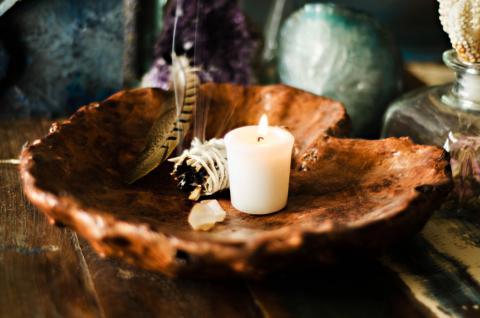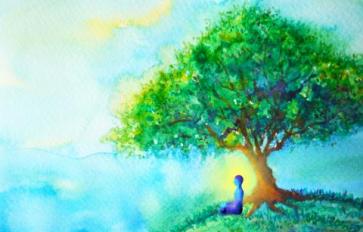
Lighting the candle and stick of jasmine incense, I arrange the multi-colored stones into a pattern to reflect the harmony and depth I seek. In the corners of the table, set aside just for such a daily ritual, I place one pinecone, one feather, one small bowl of water and one tea light—each representing one of the four directions and corresponding elements. In the center, the original candle burns, standing in as me—the light of consciousness aware of this life. My altar is an outer expression of my inner dreams and fears. It is the place where I allow my inner realm to spill onto the silken offering of this physical reality. It is the space where I make a plea and an intention with my actions, to align my life more fully in accordance with the authentic path I came here to lead.
Altar-building has long been a pastime of mine. It has taken on many manifestations, as have I, in growing through the stages of time and experiences one meets while walking the individual path. Back when I was a child, my altar looked more like a pile of rocks and leaves collected in the yard and neighbors’ yards on my regular frolic through the sun-bedazzled day. Often times it would end up decorating a particular drawer until it just could hold no more outdoor magic and it came spilling into my room only for my mother to demand me return it to the wild—where she believed its rightful space to exist was. But even then, I sensed a sort of glimmery blessing coming through my intentional offerings as I laid them in my room “outside” of their regular space and time. It was like they knew of me, and I of them…and so my life began to slowly transform in accordance. And my return to the sacred took a space in my “outer” reality.
My first certified “temple” ever erected was at the base of a young oak tree. You could crawl under some lower branches and find yourself cradled in the bowl-like patch under the shade of the boughs. I used to spend hours in this lovely tree’s shade, hidden away where no one could find me. I would bring offerings of stones, leaves, cool looking twigs and branches, and sometimes even robin eggs I had found cracked open, or abandoned bird’s nests. In this space I could feel cradled by a higher power. It was my own private church of the divine and in its field, I was known and cared for.
Later in life, when I used to travel for months at a time throughout Asia and SE Asia, my altars looked a little different. They were fluid and set up in a moment’s notice at the particular guest house or cottage I was staying in. Sometimes my time there would only be a night, so my altar was also simple, yet poignant. I used to carry a statue of Ganesha, the Hindu elephant deity representing the removal of obstacles, or Shiva—god of detachment, creation, and destruction. I would set these atop a beautiful scarf or piece of fabric I had acquired in my journeys. A few stones would sit near the statue and incense would burn to bless the space and ignite that space in my consciousness which remembers who I am. In silent days spent in deep contemplation of what I was discovering there, my altar served as a grounding point for my consciousness, and with the strike of a match to light the incense I would instantly be teleported into the realm of the “seen” with my own personal inner God.
Today, my altars are ever-changing from day to day or week to week. Sometimes a particular beloved arrangement may stay months, if the vibration feels right. But usually altars morph with us and are used to assist us in either holding or transmuting a specific energy or purpose. Candles sit on my altar to light my awareness and often times oracle cards or spreads will stay in order to remind me of the lessons or insights I was gleaned in a reading. Crystals always beautify and potentize the space. I often let my kiddos bring in feathers, leaves, and other outside treasures to add to either the main home altar or one they have built themselves.
Through keeping an altar as a family, we thereby strengthen both our personal connections with a higher power, as well as the group field and resonance we each have with one another, on a deeper level, as well as growing a healthy respect for the way each other acknowledges the Divine.
I can remember when it really hit home for me how potent and desirable altars and the keeping of altars was. I was in India and I noticed that everywhere I turned there was an altar or a small temple. In cars, aboard trains, on street corners, in taxi cabs, at bus stops, in buses, in banks, in every business, in every home, everywhere. They were a constant reminder, not only to me, but to every person who saw them, daily, of the sacredness of life. I could feel it. I recognized right away that India was holding a spiritual vibration, a consciousness that was unlike anything I had felt anywhere else in the world. It is actually what made me fall in love with it there.
The altars kept in India were alive. They broadcasted faith and honor. They spoke of the importance of relying on the Unseen Universal Source Power above all else. This showed in the life of the people, their hospitality, their kindness and lack of fear. There was an openness I longed to embody and during my times traveling there I, little by little, gathered up my understanding and carried it home in the backpack of my consciousness.
Today, if placed in a home or property for long, you will begin to see altars popping up all around. Above the kitchen sink, in the bathroom, next to the bed, on the front porch, in the garden. They don’t have to be elaborate, but they are a reminder to everyone who peers upon them, and especially a reminder to me, that the sacred is here, that we are and life is—holy.
To “keep” an altar is to stay in vigilance of order, of what feels “ready to move,” both in your life and on the altar. It is the outside space where we see with our eyes “what wants to stay,” energetically and lend further support and blessing to the purpose there. When incense and candles are a part of the scene (which in my corner of the world they always are) it becomes part of the job of the “temple/altar-keeper” to maintain cleanliness, to clear off the old ashes and bring freshness regularly so the altar can perform its function of constantly anchoring the awareness of the sacred.
You can create an altar too, or if you already have one, perhaps you have gleaned here from my stories how you might up-level your experience and interaction with altars. I know, for me, they allow me deeper connection, they open my capacity to ‘see’ my environment and inner world anew, and they teach me.







